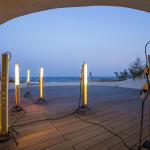Leelee Chan 陳麗同
Sunset Capsule 日暮胶囊, 2019
construction lights, metal stands, crystal pieces from a scavenged chandelier, concrete, fiberglass, metal hardware, gel filters
三防灯、铁架、拾得水晶灯零件、混凝土、玻璃纤维、金属零件、滤光片
Installation dimensions variable 尺寸可变
Each light ranges from 146 x 38 x 38 cm to 150 x 38 x 38 cm
每件灯尺寸由 146 x 38 x 38 cm 至 150 x 38 x 38 cm
Each light ranges from 146 x 38 x 38 cm to 150 x 38 x 38 cm
每件灯尺寸由 146 x 38 x 38 cm 至 150 x 38 x 38 cm
Site-specific sculptural installation for Capsule 胶囊场域特定雕塑装置作品
更多图片
-
(View a larger image of thumbnail 1
)

-
(View a larger image of thumbnail 2
)

-
(View a larger image of thumbnail 3
)

-
(View a larger image of thumbnail 4
)

-
(View a larger image of thumbnail 5
)

-
(View a larger image of thumbnail 6
)

-
(View a larger image of thumbnail 7
)

-
(View a larger image of thumbnail 8
)

-
(View a larger image of thumbnail 9
)

-
(View a larger image of thumbnail 10
)

'Sunset Capsule' (2019) is an individual work from a light installation developed for Chan’s first solo exhibition 'Core Sample' at Capsule, Shanghai. The light stand structure resembles the one used...
"Sunset Capsule" (2019) is an individual work from a light installation developed for Chan’s first solo exhibition 'Core Sample' at Capsule, Shanghai. The light stand structure resembles the one used by construction workers in Hong Kong out of practicability, turning a construction light into a free-standing light made out of rebars. This kind of construction light can be found everywhere in Hong Kong, usually being placed over footbridges, parking spaces, communal areas, but often completely overlooked by people.
In this instance, Chan’s ambition was to give individuality to this ready-made object by inserting concrete casts and colour filters inside the lighting case to create a unique composition for each case. At a closer look, the viewer can discover “micro-worlds” within the work: the concrete cast of white cement and pumice inside the light; construction materials combined with found objects such as discarded bolt heads and crystal pieces from a chandelier.
The idea to use orange and amber colours came about when she lived and worked in Zhujiajiao (China) for three months prior of her exhibition at Capsule. During her residency there, she became highly aware of the drastic change of light in the mornings and afternoons of a Shanghai winter: the sun would set at around 4 pm - much earlier than in her homeland in Hong Kong - and turned sunlight into something precious that she tried to “catch” as much as possible every day. There was something interesting about the idea of the sun contrasting the cold and dark winter nights, which compelled her to “re-create” an eternal sunset for the winter garden of the gallery. The cold fluorescent construction lights were thus manipulated into an amber light that generates warmth and heat.
《日暮胶囊》(2019)是陈丽同在胶囊(上海)举办首次个展“核心样本”时为展览空间创作的一件场域特定灯光装置。灯具的结构灵感来源于香港工地常见的施工三防灯,为了便捷,常常被固定在钢筋架上成为落地灯,在香港的行人天桥、停车场、公共空间等地随处可见,却常被忽视。
在此,陈丽同的创作意图是为这一现成物赋予独特性。她在灯罩内部加入了混凝土铸件与彩色滤光片,为每一个灯箱构建出独一无二的组合。细看之下,观众可以在作品中发现一个个微缩世界——白水泥和浮石铸成的灯罩,建筑材料与废弃螺帽、水晶吊灯碎片等拾得物相融合。
选择橙色与琥珀色是由于陈丽同在展览前于朱家角驻地三个月的经历。她对上海冬季早晚光线的剧烈变化印象深刻。下午四点左右日光就会迅速消失,比香港要早了许多,也使得阳光变得格外珍贵。她每天尽力“捕捉”短暂的日光。太阳与冬夜的寒冷黑暗形成的反差令她感到有趣,也使她萌生了在画廊的冬日花园中构建一个永恒日落的想法。荧光冷冽的三防灯在她的手中幻化为温暖的琥珀色光芒,带来一缕日光的余温与慰藉。
In this instance, Chan’s ambition was to give individuality to this ready-made object by inserting concrete casts and colour filters inside the lighting case to create a unique composition for each case. At a closer look, the viewer can discover “micro-worlds” within the work: the concrete cast of white cement and pumice inside the light; construction materials combined with found objects such as discarded bolt heads and crystal pieces from a chandelier.
The idea to use orange and amber colours came about when she lived and worked in Zhujiajiao (China) for three months prior of her exhibition at Capsule. During her residency there, she became highly aware of the drastic change of light in the mornings and afternoons of a Shanghai winter: the sun would set at around 4 pm - much earlier than in her homeland in Hong Kong - and turned sunlight into something precious that she tried to “catch” as much as possible every day. There was something interesting about the idea of the sun contrasting the cold and dark winter nights, which compelled her to “re-create” an eternal sunset for the winter garden of the gallery. The cold fluorescent construction lights were thus manipulated into an amber light that generates warmth and heat.
《日暮胶囊》(2019)是陈丽同在胶囊(上海)举办首次个展“核心样本”时为展览空间创作的一件场域特定灯光装置。灯具的结构灵感来源于香港工地常见的施工三防灯,为了便捷,常常被固定在钢筋架上成为落地灯,在香港的行人天桥、停车场、公共空间等地随处可见,却常被忽视。
在此,陈丽同的创作意图是为这一现成物赋予独特性。她在灯罩内部加入了混凝土铸件与彩色滤光片,为每一个灯箱构建出独一无二的组合。细看之下,观众可以在作品中发现一个个微缩世界——白水泥和浮石铸成的灯罩,建筑材料与废弃螺帽、水晶吊灯碎片等拾得物相融合。
选择橙色与琥珀色是由于陈丽同在展览前于朱家角驻地三个月的经历。她对上海冬季早晚光线的剧烈变化印象深刻。下午四点左右日光就会迅速消失,比香港要早了许多,也使得阳光变得格外珍贵。她每天尽力“捕捉”短暂的日光。太阳与冬夜的寒冷黑暗形成的反差令她感到有趣,也使她萌生了在画廊的冬日花园中构建一个永恒日落的想法。荧光冷冽的三防灯在她的手中幻化为温暖的琥珀色光芒,带来一缕日光的余温与慰藉。
22
/
22












